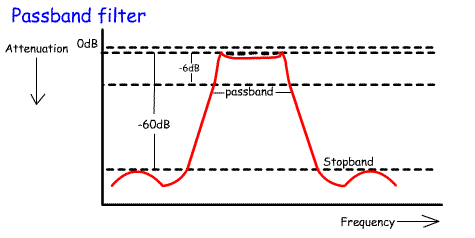
| ADVANCED LESSON 42 |  |
| LEARNING OBJECTIVES and NOTES | |
|
Receiver parameters and terminology In order to compare one receiver with another a number of tests are used on receiver parameters. Key parameters include selectivity, dynamic range and signal to noise ratio. |
|
|
4j.1 Understand the terms selectivity and 60 dB bandwidth. A receiver's selectivity is its ability to select a wanted audio signal from an unwanted one. This is achieved by using filters which ideally are rectangular with straight sides, but in practice have sloping sides as shown in the drawing. These real-life filters will have a bandwidth that is narrower at the top than at the bottom. The narrower the filter the better the selectivity. So:-
The -60dB line shows where the signal has fallen in strength by 60dB from the top of the filter |
 |
|
4j.2 Recall that the dynamic range of a receiver is the difference
between the minimum discernible signal and the maximum signal without
overload. Recall that dynamic range is expressed in decibels. The dynamic range is the difference between the minimum detectable signal and the maximum signal that can be received without overloading the receiver. A weak signal will be down in the noise and what is required is a receiver designed to have low noise from the circuits and maximum gain. A strong signal will overload the receiver and what we need here is an ability to reduce the signal strength rapidly. To put some figures on it if we assume that 51.2 microvolts at the antenna input gives a reading of S9. A signal at S0 (S zero) would require (0.1 micro volts). This is the weakest and S9 + 60dB (52.48 millivolts)is the strongest. The S meter is calibrated so that 1 S point = 6dB So the weakest signal =9x-6 = -54 dBs below S9 and the strongest signal is +60dB above S9. The dynamic range = -54+60 = 114dBs. Or a range from 0.1 microvolts to 52.48 millivolts. |
|
|
4j.3 Recall, in simple terms, the meaning of “signal to noise ratio” as
applied to a receiver specification. Recall that the noise generated in
the receiver will influence the minimum discernible signal. NB Signal to noise ratio is given the abbreviations SNR and S/N The signal to noise ratio in a receiver is defined as: SNR = Ps / Pn where Ps is the average power of the desired signal where pn is the average power of the undesired noise. To make this fair, the two have to be measured at the same frequency and with the same bandwidth. The higher the noise level generated by circuits in the receiver, the more difficult it is to understand weak signals. |